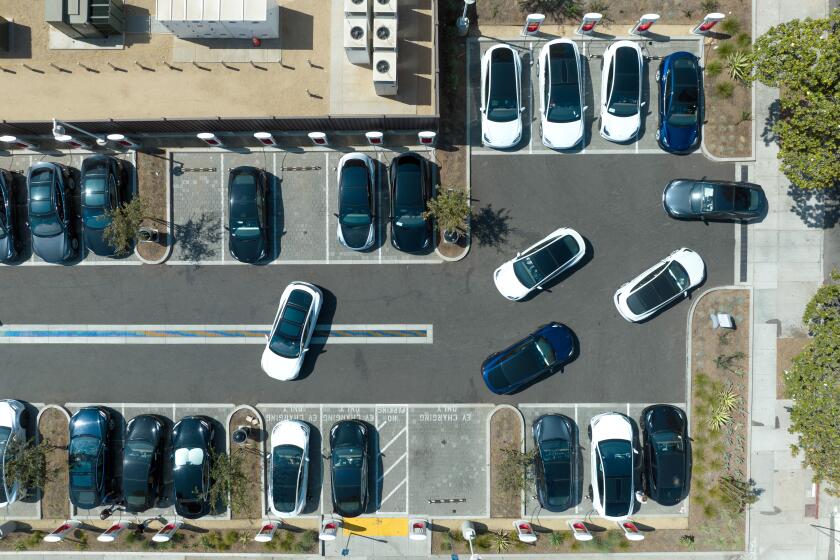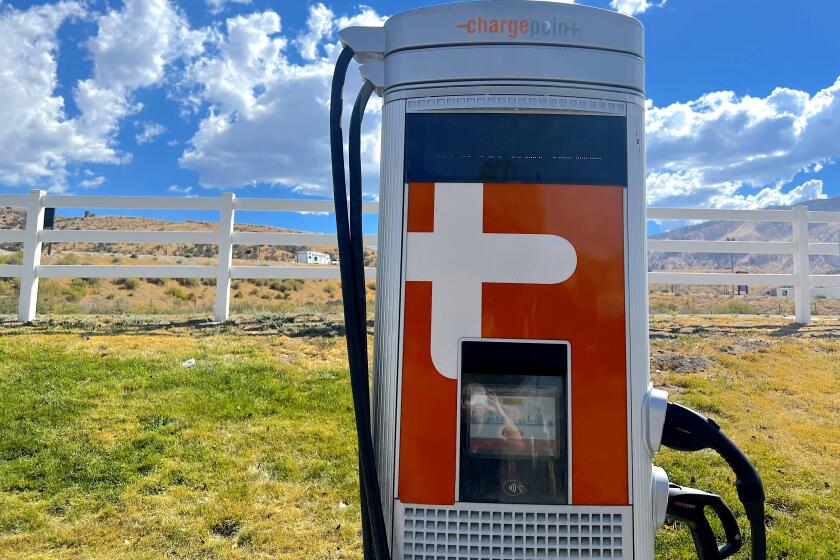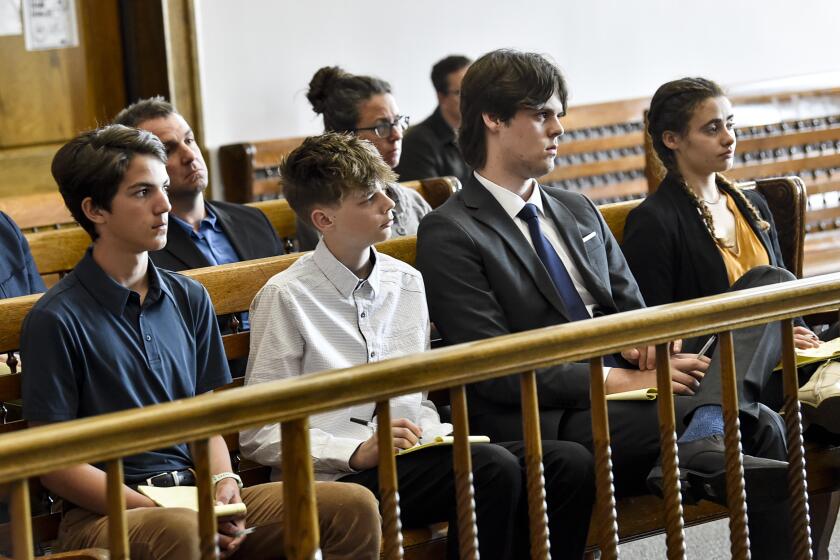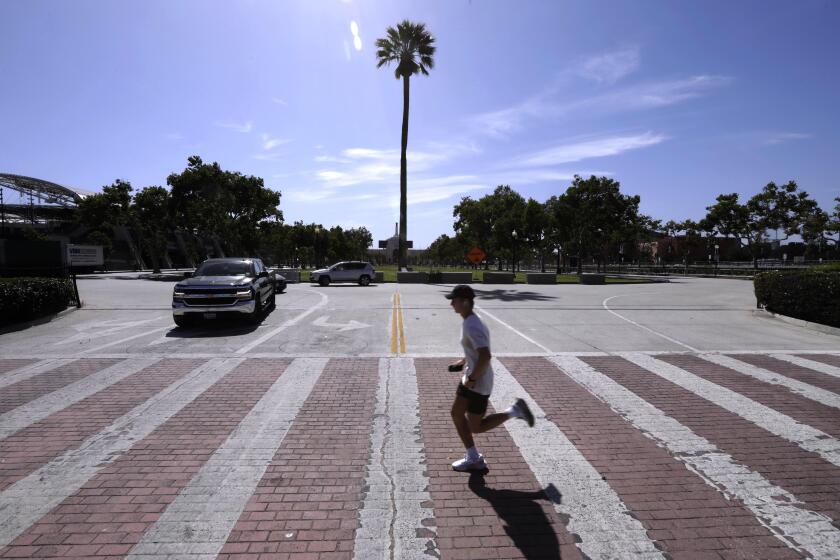
Jorge Cortés loves his 2021 metallic gray Toyota Prius Prime. It’s a plug-in hybrid car, with a small battery and a gasoline engine, and he runs it on the battery whenever he can. “It’s a great vehicle,” he said.
Cortés lives in Richmond, north of Berkeley, earning his income building treehouses and other play structures. Most of the time, the 25-mile battery range is enough to get him to work and back. The gas engine’s available for longer trips.
“It’s 400 miles from my house to Universal Studios,” Cortés said. “I drove my kids down there and didn’t have to fill up once.”
But Cortés’ love of plug-in hybrids is not shared by many environmental groups and other fossil fuel foes, who hate the technology. Cars like Cortés’ will only delay California’s ambitious transition to an all-electric fleet, they say, because too many owners don’t bother to plug them in.
As automakers and state officials confront the reality of producing and powering EVs on a massive scale, feuds over the best way to reach the state’s EV goals are bound to continue.
Aggressive and impactful reporting on climate change, the environment, health and science.
To many consumers, plug-in hybrids fall on the gas-battery spectrum somewhere between hybrids and all-electric vehicles.
Where a regular hybrid car runs on gasoline, using battery power to improve gas mileage, a plug-in hybrid can go a few dozen miles on battery power alone. A regular hybrid has no plug to recharge a battery: The gasoline engine takes care of that. The plug-in hybrid can be attached to a wall socket or an EV charger for a battery refill, at home or at work, and the gas tank can be refilled at a service station.
That’s enough for fans, who see plug-in hybrids as a way to drive on mostly pure electric power and not have to worry about iffy public chargers on longer routes. They consider them a more flexible alternative to all-electric vehicles, in particular for those who rely on a single car. Foes, including Greenpeace, the Sierra Club and other environmental groups, say plug-in hybrids depend too much on fossil fuels and don’t make sense for anybody.
Plug-in hybrids made up only about 3% of automobile sales in California for the first half of 2023, compared with about 21% for pure electric cars and trucks. But sales are growing. Customers have wide choice: At least 32 plug-in hybrid models are available for lease or purchase in the United States, with EV-only ranges between 17 and 44 miles. (That doesn’t count two Ferrari supercar plug-in hybrids, whose 9- and 10-mile batteries are there to boost power, not to cut pollution.) Americans drive cars an average of 37 miles a day, according to Kelley Blue Book.
Surprisingly, perhaps, plug-in hybrids play an essential role in California’s plan to ban new sales of internal combustion cars.
A little known fact: What the state of California calls zero-emission vehicles aren’t all zero-emission vehicles. The wording in Gov. Gavin Newsom’s decree that 100% of new passenger vehicles sold in the state be “zero-emission” effective in 2035 is not quite accurate. Of those new cars and trucks, 20% can be plug-in hybrids, with gasoline engines.
As autos writer for the L.A. Times, Russ Mitchell gets a lot of questions about electric car buying. Here’s his guide to choosing the right EV for you.
Why does California carve out an exception? Though plug-in hybrids “don’t provide the same level of emission reductions, we do still encourage [their] sales as one of several consumer options,” said Dave Clegern, public information officer at the California Air Resources Board. Plug-in hybrids “may work better for some drivers who don’t have access to fast charging, for example.”
One reason car companies continue to offer them even though their market share is small: Each sale helps achieve federal fuel economy standards, known as CAFE, and meet state zero-emission vehicle rules. “Right now they’re [helping meet] CAFE in the near term until electric vehicles have critical demand,” said Dan Hearsch, an auto industry consultant at AlixPartners, an international consulting company. “They have to have them in the fleet to continue to advance up the curve.”
The cars are several thousand dollars more expensive than regular hybrids because of the larger battery and the parts and engineering required for recharging. Some of the cost can be offset through tax breaks, government rebates and other incentives that are income based. A new Toyota Prius Prime, with a 44-mile battery range, carries a $32,350 base price, almost $5,000 more than the regular Prius hybrid.
Plug-in hybrids qualify for HOV lane decals, again depending on income. Buyers who earn more than $150,000 for single filers, $204,000 for head of household, or $300,000 for joint filers: No stickers for you. This benefit was a big selling point for Cortés: “That alone saves me 10 to 20 minutes for my commute every day,” he said.
Critics are unimpressed, however.
If people are turning to plug-in hybrids as a way to help combat global warming, they and the climate would be better off if they drove a small, efficient, gasoline-sipping economy car instead, said Julia Poliscanova, a senior director at Transport & Environment, a Europe-based clean transport campaign group. (Americans in general profess a strong interest in cutting back on greenhouse gases but have come to shun such vehicles in favor of SUVs and pickup trucks.)
“We call the plug-in hybrid fake electric,” she said. “You are dragging around a heavy vehicle with an undersized engine.”

Subscribers get exclusive access to this story
We’re offering L.A. Times subscribers special access to our best journalism. Thank you for your support.
Explore more Subscriber Exclusive content.
Furthermore, she said, while driving a plug-in hybrid in all-electric mode produces zero tailpipe emissions, studies done by her group and others show that large numbers of plug-in hybrid owners often forget or don’t bother to charge their cars overnight.
Still, California supports them — or at least qualifies them as a fudge factor in case the shift to full electric vehicles by 2035 doesn’t go as smoothly as planned. The air resources board says concern about universal access to fast chargers is the main reason for the 20% plug-in hybrid allowance. But other risks might explain why California policymakers are hedging their bets on the all-electric 2035 goal.

For one thing, the California plan to ban sales of new internal combustion cars, like similar proposals in Europe, is remarkably ambitious. It relies on several factors that must line up in a short period of time: customer acceptance, trustworthy public charging, battery cost and supply, and reliable foreign sources for minerals essential to an electricity-based economy.
Automakers will be required to sell electric vehicles in increasing numbers over the next decade or so. The zero-emission mandate moves from 35% in 2026 to 76% in 2030 to 100% (or 80% with plug-in hybrids included) in 2035.
Plenty of challenges lie ahead as California mandates zero-emission cars, including cost and access to charging.
Electric cars are selling well now, but no one knows if the trend will continue. Buyer enthusiasm is hardly the only risk. The state has pumped millions of dollars into today’s public charging system, with billions more on the way. But it’s proved to be a mess. Except for Tesla’s Superchargers, public chargers remain highly unreliable, and California regulators have yet to pass firm rules on grants and loans to charger companies that tie taxpayer funding to the quality and reliability of their system’s performance.
Tesla has managed to build a dependable charger system for its own cars. Frustration with charger companies, including ChargePoint, Electrify America and EV Go, pushed Ford, GM and other automakers to strike deals with Tesla to allow their cars to use the Supercharger network. It remains to be seen when that will happen, how well that will work, and how much Tesla will charge.
Another reason for California to hedge its bets: batteries. Right now there’s not nearly enough supply to meet the growing market for EVs.

The Biden administration’s energy bill ties federal tax rebates for electric car buyers to requirements that EVs be assembled in North America and that certain battery components be sourced in the U.S. or from closely aligned trade partners. That’s sparked a battery manufacturing plant construction boom in the U.S.
Cost and quality issues could impede EV development. With a surge of new battery plants in the pipeline, the rapid pace of construction and the arrival of untested players lured by government subsidies, there’s plenty of room for inefficiency. “A large proportion of production is set to come online from outside of the Asia Pacific region, but more than a third of that production is tied to or coming from producers that are untested or unqualified,” said Andrew Miller, chief operating officer at Benchmark Mineral Intelligence, which tracks the global markets and politics of minerals and mining.
Another wild card: hardball politics. Ford had started construction on a $3.5-billion battery plant in Marshall, Mich., using technology licensed from giant Chinese battery company CATL. To date, only Chinese companies manufacture the lithium-iron-phosphate batteries Ford wants to build. Tesla uses them. Such batteries are more environmentally friendly and about 20% cheaper than the nickel-heavy batteries in common use, although their range is more limited.
Subscriber Exclusive Alert
If you're an L.A. Times subscriber, you can sign up to get alerts about early or entirely exclusive content.
You may occasionally receive promotional content from the Los Angeles Times.
But Ford has faced heavy criticism from Republicans in Congress for licensing Chinese technology, even though the U.S. plant would hire U.S. workers and only enough Chinese engineers to help get the plant up and running.
Then the United Auto Workers union went on strike, insisting that carmakers’ new battery plants be unionized. Perhaps there are other reasons — Ford won’t say. But on Sept. 25, Ford said it will cease construction at the plant for now. Another battery plant, planned for central Illinois, would belong to Chinese battery maker Gotion. That plant’s also under scrutiny from House Republicans.
International tensions could affect the supply of materials, too. Access to rare earth metals and other minerals essential to the design and manufacture of batteries and electric motors is not guaranteed. There’s deep anxiety about China’s hammerlock on minerals, in mining and in industrial processing.
A trip from the Bay Area to Southern California highlights the miserable state of the charging network available to many electric vehicle drivers.
China alone will produce about 75% of all lithium-ion batteries, refine 62.5% of the world’s lithium supplies in 2023, 76% of cobalt, 65% of natural graphite and 72.5% of synthetic graphite supplies, according to Benchmark forecasts.
If things don’t work out as Newsom and the California Air Resources Board have planned, the rules could always be changed. That’s happened several times for California air rules in the past.
Ford, for one, is upfront about leaving its options open, with a mix of all gasoline, hybrid and electric cars and trucks. Plug-in hybrids “are going to be really compelling, and anyone who says it’s got to be all electric ... doesn’t understand the propulsion part of this transition,” said Ford Chief Executive Jim Farley. Ford’s all-electric F-150 Lightning pickup truck and the Mustang Mach-E are just the start of a deep company commitment to EVs, he said.
Some environmental groups say Japanese car companies such as Mazda and Toyota are pushing plug-in hybrids because they’ve been slow to make the change to all-electric vehicles. But Gill Pratt, chief executive at the Toyota Research Institute in Los Altos, said Toyota’s commitment to hybrids and plug-in hybrids is intentional.
Pratt predicts shortages of lithium and other battery materials over the next decade. “There simply isn’t enough for a full EV switch-over,” he said. “We think plug-in hybrids are really important.”
The state’s 2035 20% zero-emission loophole requires a minimum 50-mile range for plug-in hybrid batteries. Few cars meet that threshold today, but Pratt said battery technology’s fast advancement means the minimum range will prove easy to meet.
The years between 2023 and 2035 will tell whether Pratt and other plug-in hybrid proponents are right. California’s zero-emission credit system for automakers favors all-electric vehicles. But the state’s 20% plug-in hybrid exception leaves a little wiggle room for the internal combustion engine.







